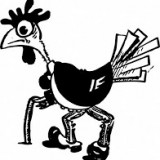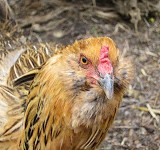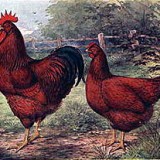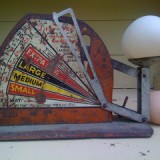
A big commercial fodder system. We need something much smaller!
I feel somewhat guilty about having our five hens in a confined coop/run. Ideally they’d be grazing on green pasture all day. But our abundant urban predators, lack of space and dry climate make the vision of hens clucking on verdant fields a challenge.
I’m thinking of building a DIY fodder system but I’m a bit confused by the instructions I’ve seen floating about the interwebs. Which is where you come in. Have you built a fodder system? Do you know any good instructions? How big should it be for five hens? Or do you know of a reasonable off-the-shelf option? In our climate I think I can keep it outside.
Leave some ideas, notions and links in the comments:






This article describes a system using 6 five gallon buckets, some cinder blocks, and a scoop. It works very well for me and is simply.
http://brinkoffreedom.net/homesteading/dead-simple-fodder-system/
Jack at the survival podcast has a pretty simple fodder system set up. http://www.youtube.com/watch?v=KbJwbnSrdT0
This blog that I follow has a pretty good rundown on their simple fodder system: http://fmicrofarm.com/diyprojects/
Good luck!
Also, This (very lengthy!) forum discussion has some fantastic tips and discussion about different set-ups and challenges you may face with fodder. It takes awhile to sift through it all, but it is definitely worth the read!
http://www.backyardchickens.com/t/713334/growing-fodder-for-chickens
Watch the movie ‘Dive’. That is the urban foraging system we have used to feed our 6 hens for over a year.
We supplement with homegrown greens: discarded veggie plants at season end, weeds from the pathways and gardens, past-prime veggies, and a few near-perennial Italian dandelion plants (that I planted because you spoke so highly of them, but turned out to be WAY to bitter for my family! the hens love ’em).
I plant the italian dandelion plants right around the hen enclosure where the hens’ scratching kicks up dust I’m not sure I’d want on human food. I have a few other tough hen-friendly plants there: nasturtiums, arugula.
I am working on this also in my yard. Two plants I am working with are Moringa and Kenaf, which both produce high levels of protein. Both grow prolifically in the heat and are supposedly tolerant of drought. Both plants are also good for human consumption. Both also have been used in Caribbean and African nations to produce fodder for livestock, specifically I have heard of chickens and rabbits. Unfortunately, even though Kenaf is a Hibiscus it produces leaves that look similar to marijuana so that might be problematic. The Kenaf “everglade” variety does not produce marijuana like leaves but I have not been able to locate it. I have also though bamboo might be useful being that it grows like crazy.
Hey Matt, that’s a great idea that I didn’t think of. I even have a moringa tree that’s a few years old (though it’s not doing well in its present location, for some reason). Will look into kenaf even if I could get busted!
Here’s how I do it. Super simple, nothing special. I would just do one tray at a time for 5 hens. http://www.dogislandfarm.com/2013/03/what-fodder.html
This is my ridiculously simple fodder system setup for my rabbits:https://suburbanreject.com/blog/2014/01/10/fodder-growing-system/
I have an even simpler setup going for my 5 chickens. There will be a post going out on our blog next Friday about it. Feel free to email me if you are interested in seeing it and I will email you out the info/pics before the post goes live.
-Fin
This interests me immensely! I will not be able to let my hens forage freely after knee surgery. For a month after back surgery, someone will feed them. This fodder system will make it easy for someone to give them food they need.
Would it be possible to homegrow all the food the hens need? Or would it be cheaper to buy chicken food from the store (in bulk)?
(I don’t have chickens!)
It’s possible but not on a small urban lot like ours. Even if I had a farm with a big pasture I think I’d still have some feed on hand as a supplement.
I read somewhere that Backwoods Home Magazine has an article on fodder.
Always good to hear from you PP. There’s one in the current issue but it’s a bit scarce on details. It’s actually why I asked this question.
http://www.youtube.com/watch?v=BzSKcj481pc
I started out with 5 chickens and worked my way up to 34, This is how I do it and I got it off this web-site. I made my own stand with refrigerator racks. I how it helps. It is a low tech fodder system.
http://www.youtube.com/watch?v=bXMAolO6r3Q
My keyboard is worn out and I meant to say I hope it helps……
We have just started sprouting Barley for our 6 hens and are very pleased so far. We do free range our hens when we can but are in Canada and with a foot of snow and very frozen ground this is not possible for many months of the year. We would also recommend looking at Jack’s bucket system and Sarah at fmicrofarm (listed above), Ourhalfacrehomestead.com also has a similar simple system. We actually haven’t had time to build any shelving – just decided to dive in with it, got the bag of barley and are sprouting it in recycled clear plastic trays (with holes punched in the bottom to drain) in our kitchen. They are just sitting on window sills at the moment. Others have reported mixed reviews re. how the ir chickens took to it at first but ours seem to love it. We are paying $33.00 a bag for organic feed ($13.00 for the bag of barley and of course produces many times more food when sprouted) so we certainly welcome this opportunity to save and give the hens a very high level of nutrition at the same time. We are still giving 1/2 the amount of reg. feed with the barley fodder. Have really enjoyed your blog and books!
Howdy, We grew wheat grass, barley grass and pea shoots- well we ate the pea shoots too- for 7 hens to keep them happy through snowy VT winters. We didn’t use a big system, just a series of seedling trays (I think we ended up settling on a rotation of 9-10 trays) on a wire shelving unit with LED grow lights suspended on one layer when the light from the window was not enough. (Remember the seeds don’t need the light while sprouting, also we pre-soaked all the seeds) Once we got it going it was really not more than a couple of minutes at most of care a day. Definitely worth it!
Now see, that’s all way too much work for me. Instead I like growing lots of different kales and a walking stick collard (kale?). They grow all winter north of you in the bay area, and at some point I had a few plants that were nearly 4′ tall. Every day I break off a small branch from one of the many kale plants and throw it at the hens. Nutritious, practically zero work, and I can eat it too.
I have been feeding my chickens (and rabbits) sprouted barley fodder for a year now and have nothing but good things to say about it. The chickens were a bit picky at first, but now they eat the grass, seeds, and root mat in its entirety with no issues. Their egg production has not decreased and their yolks are a nice deep orange. All I do is supplement grit and calcium,otherwise they eat fodder as 90% of their diet.
I also have a bunch of YouTube videos, free fodder Printables, and even some photo tutorials on my website: http://www.fmicrofarm.com
Good luck! You and your chickens are going to love it!
This is what I do:
Line a 5 gallon bucket with an old pillow case. Pour about half full of barley/oats/wheat/etc. Fill with water and leave overnight. The next day, pull the pillowcase and set somewhere you want the water to drain. Reset your bucket. Turn the hose on the pillow case everyday to keep moist. Lather rinse and repeat. You will need 1 bucket and about 6 pillow cases. Enjoy!
A simple black 10″ x 20″ nursery tray, a frizbee or a shallow cardboard box. Poke a couple small holes in the tray, add a layer of your seeds, mist or water until the plants grow, then feed them to the hens! you can get nursery trays for about $1-2 and use a pre-made shelving unit or make one from pallets. If needed you can feed the seedlings with a little fish emulsion or liquid organic starter plant food. Automated systems can be made with a single sprinkler valve and timer. Connect to the water line or use a 5-25 gallon bucket and use gravity. For finicky hens you can use the water from canned corn or veges to water the fodder mat. The hens will go crazy for the fodder! Sorry to self promote but I am available for consults and food garden services in OC and SD.
On the top u can grow salad or something ,the system is not only a fodder system .
I have build a similar system which is smaller with rain gutter for growing salad and herbs,it was big enough for about 8 months now the local supermarket is having a corner with local produced and is interested so now i have to have a bigger one.
My advice: better oversized than undersized.